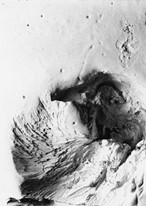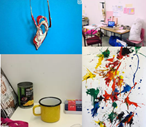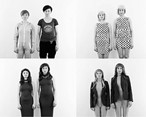Our reasons for decorating the body are wide-ranging and complex and the wearing of jewellery (shell beads) is the earliest recorded form of modern human behaviour, dating back over 100,000 years. Historically, people have expressed themselves through relatively superficial body adornment to extremely sophisticated symbols as a means of communicating the concept of position, rank, status, etc.
Contemporary studio jewellers continue to challenge perceived boundaries and use the artefact as a way of defining a personal response to social and cultural issues such as gender, relationships politics, and the environment. Similarly, silversmiths explore this interaction between fine metalworking and ideas, through the vehicle of the functional domestic object.
The department embraces this diversity through informed debate and discussion. It encourages students to develop a personal approach to the research and development of lively design solutions together with a knowledge of traditional and cutting edge technology and skill acquisition.
Whether they intend to enter the broad based jewellery and silverware industries, pursue personal expression through the gallery market or continue in academia, students will develop their skills in a supportive and confident Department.
The Silversmithing and Jewellery programme aims to provide a broad, balanced programme covering aspects of body adornment and fine metalworking from the development of original design concepts through to the finely crafted finished work. The course embraces as broad an approach to silversmithing and jewellery as possible, from designing for the mainstream jewellery or silverware industries to the pursuit of very personal works intended for gallery exposure.
A strong emphasis is placed on the development of individual craft and design skills that increasingly allow each student the freedom to pursue and realise ideas in appropriate media. Consequently, we actively encourage exploration of a wide range of materials through project work. The course centres its basic technical studies, however, in the area of fine metalworking, providing students with the experience of working in gold and silver as well as other metals.
The staff of the department, as practising designer/makers/researchers, continually review new developments in the field, evaluate the place of silversmithing and jewellery in changing international cultural environments, and respond to technological advances in design and manufacture. The programme is supported by guest lectures, field trips, professional practice workshops, live projects, themed department exhibitions, and seminar/study groups.
Design History and Theory
An element of the programme is delivered by the department of Design History and Theory. For most of the four years of undergraduate programmes in design, one day per week of the student timetable is allocated to Design History and Theory. It is an externally linked critical mass of diverse research expertise in broad-based critical studies for contemporary creative practices in design. More information on the department and staff profiles can be found here.
The First Year Experience
The First Year Experience is a new course for all first year student at The Glasgow School of Art, across the Schools of Architecture, Fine Art, Design, Innovation and Simulation & Visualisation.
The course seeks to ensure creative collaboration is at the heart of learning, simultaneously strengthening disciplinary practices and inspiring radical forms of interdisciplinarity. New first year students to GSA will experience the integration of research, practice, and theory through the course, which will foster transitions into disciplinary expertise through exposure to the wider creative context in which their chosen department and school belongs.
Design Domain
Design Domain is a 20-credit course for all Year 2 and Year 3 students in Fashion, Textiles, Communication Design, Interior Design, Interaction Design, and Silversmithing & Jewellery.
During Design Domain, you explore your design process by relating it to ideas and practice within your own design subject discipline and to ideas and practice beyond your own discipline in the wider ‘domain’ of design, including the cross-disciplinary cultural ideas and critical thinking that inform it.
Each year, Design Domain is given an overall theme, and there are four related sub-themes, with useful key words. These themes are designed to be thought provoking and open.













